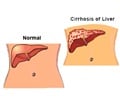New study sheds light on the genetics of primary biliary cirrhosis, a chronic form of liver disease.

Patients with primary biliary cirrhosis suffer irritation and swelling of the bile ducts of the liver - blocking the flow of bile, which normally aids digestion.
"To gain an insight into the causes of primary biliary cirrhosis we compared genetic data from patients and healthy volunteers and found 22 regions of the genome that differed significantly, 15 of which had not previously been identified," said Carl Anderson, from the Wellcome Trust Sanger Institute and one of the senior authors on the paper.
"By scrutinizing the genes within these regions we were able to identify biological pathways that appear to underpin the disease, thus prioritising these for future research and highlighting their potential for therapeutic intervention," he said.
"This study is a key first step in our efforts to unravel the biological complexity of primary biliary cirrhosis and further research building on these results is already underway," he added.
The team found that many of the 15 new regions contain genes involved in regulation of the immune system, with three immune pathways particularly prominent.
Advertisement
"By working together, we have recruited almost one in six primary biliary cirrhosis patients in the UK; completed the largest genome-wide association study of primary biliary cirrhosis to date and established a research consortium that will form the foundation of further clinical, genetic and therapeutic studies," added Mells.
Advertisement
The results are the first to emerge from the Wellcome Trust Case Control Consortium 3 (WTCCC3) project, a collaboration of UK scientists and clinicians, which aims to unravel the role of genetic variation in several human diseases.
Source-ANI















